ERS101H5 Winter 2020 - Planet Earth: Geology of a Craton Assignment
VerifiedAdded on 2022/09/02
|9
|1353
|18
Homework Assignment
AI Summary
This assignment, completed for ERS101H5 at the University of Toronto, explores the geology of a craton through a series of cross-sections. The student describes five rock types, their formation, and the principles of original horizontality and superposition. The assignment then applies plate tectonic processes like rifting and continental convergence to the landmass, detailing how these forces affect the rock layers. Furthermore, it examines the impact of natural hazards such as impact craters and tsunamis on the rock formations. The student also addresses the effects of base level fall. The assignment demonstrates an understanding of geological processes and their impact on landforms, referencing specific rock layers like the Supai Group, Hermit shale, Coconino Sandstone, Toroweap layer, and Kaibab layer.
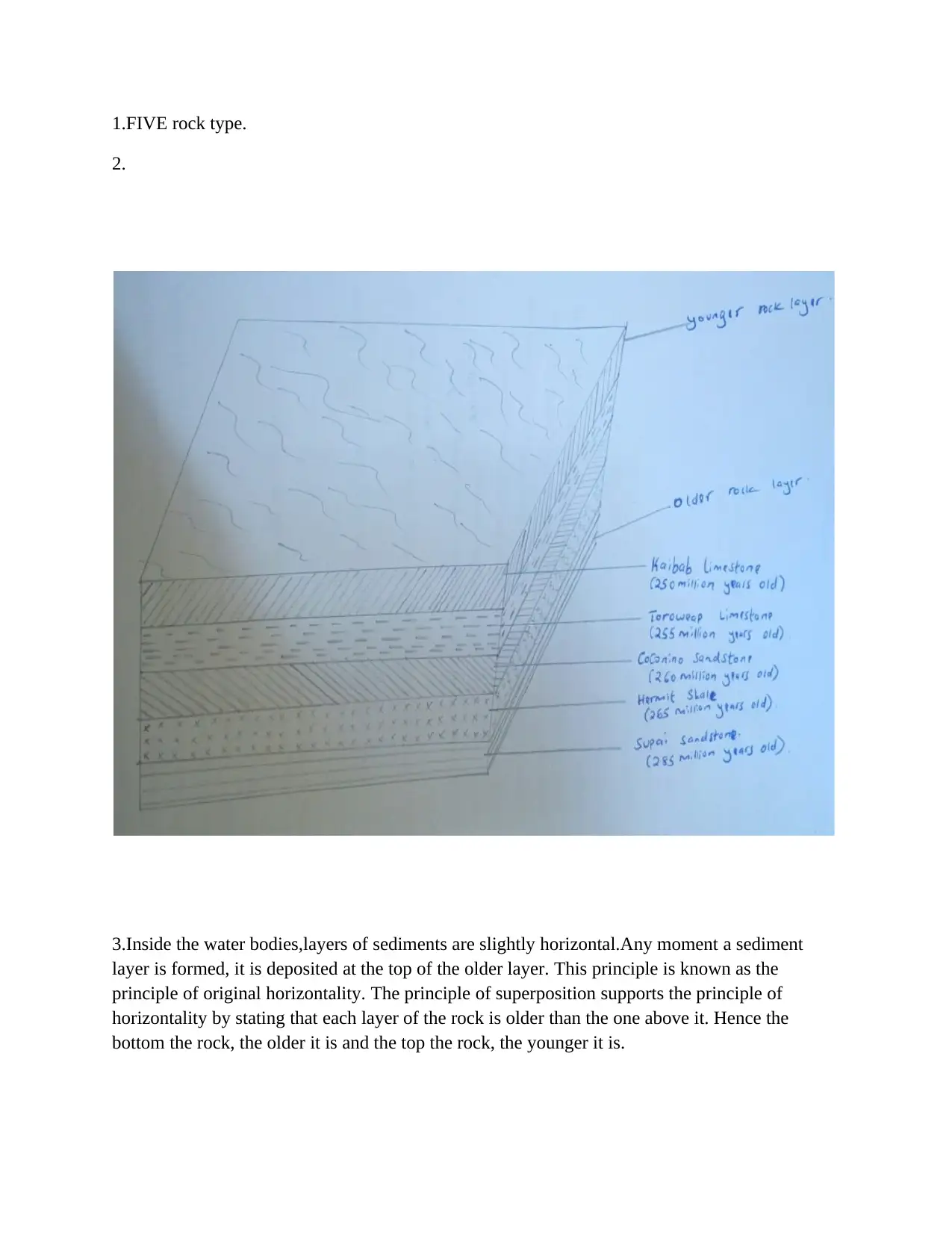
1.FIVE rock type.
2.
3.Inside the water bodies,layers of sediments are slightly horizontal.Any moment a sediment
layer is formed, it is deposited at the top of the older layer. This principle is known as the
principle of original horizontality. The principle of superposition supports the principle of
horizontality by stating that each layer of the rock is older than the one above it. Hence the
bottom the rock, the older it is and the top the rock, the younger it is.
2.
3.Inside the water bodies,layers of sediments are slightly horizontal.Any moment a sediment
layer is formed, it is deposited at the top of the older layer. This principle is known as the
principle of original horizontality. The principle of superposition supports the principle of
horizontality by stating that each layer of the rock is older than the one above it. Hence the
bottom the rock, the older it is and the top the rock, the younger it is.
Paraphrase This Document
Need a fresh take? Get an instant paraphrase of this document with our AI Paraphraser
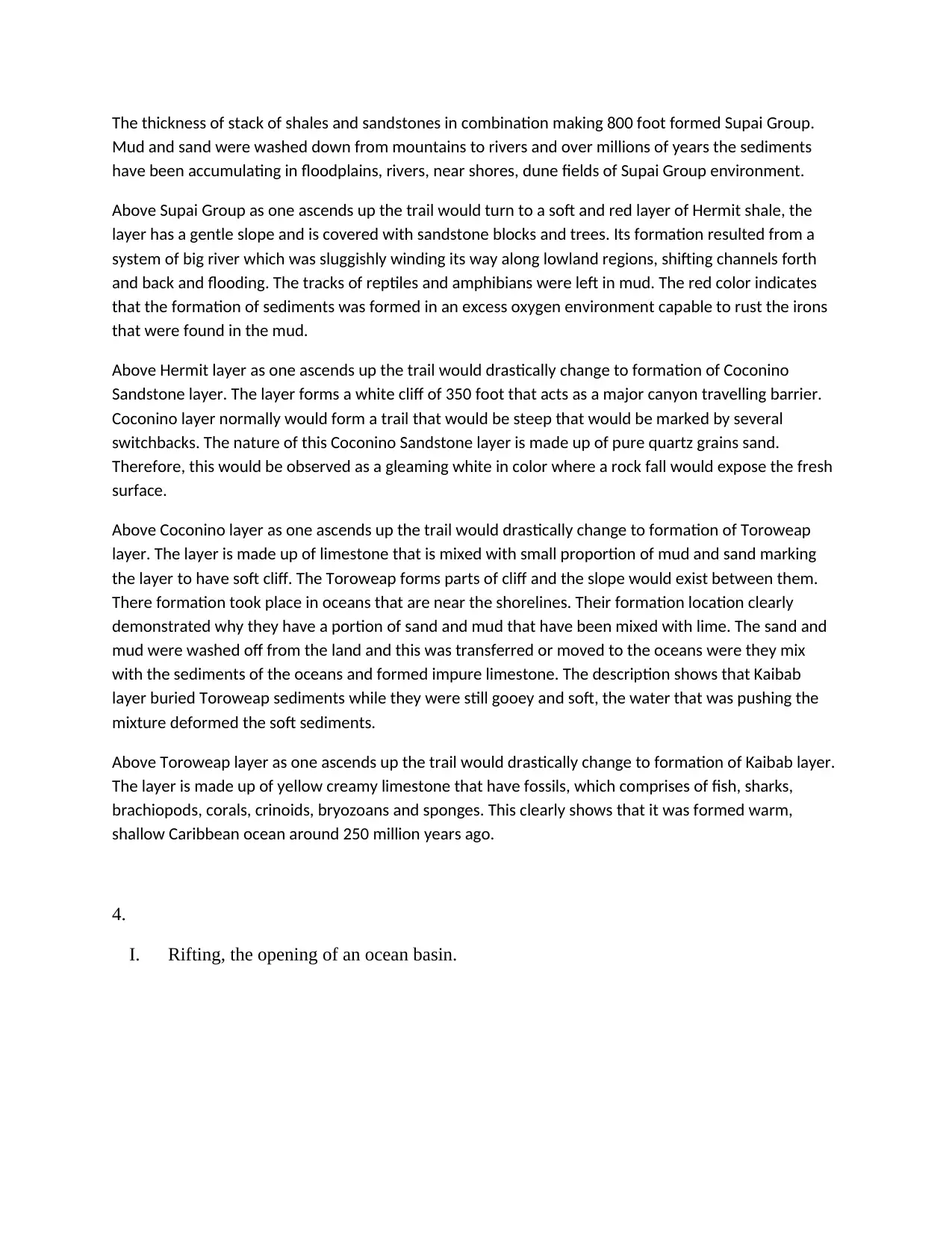
The thickness of stack of shales and sandstones in combination making 800 foot formed Supai Group.
Mud and sand were washed down from mountains to rivers and over millions of years the sediments
have been accumulating in floodplains, rivers, near shores, dune fields of Supai Group environment.
Above Supai Group as one ascends up the trail would turn to a soft and red layer of Hermit shale, the
layer has a gentle slope and is covered with sandstone blocks and trees. Its formation resulted from a
system of big river which was sluggishly winding its way along lowland regions, shifting channels forth
and back and flooding. The tracks of reptiles and amphibians were left in mud. The red color indicates
that the formation of sediments was formed in an excess oxygen environment capable to rust the irons
that were found in the mud.
Above Hermit layer as one ascends up the trail would drastically change to formation of Coconino
Sandstone layer. The layer forms a white cliff of 350 foot that acts as a major canyon travelling barrier.
Coconino layer normally would form a trail that would be steep that would be marked by several
switchbacks. The nature of this Coconino Sandstone layer is made up of pure quartz grains sand.
Therefore, this would be observed as a gleaming white in color where a rock fall would expose the fresh
surface.
Above Coconino layer as one ascends up the trail would drastically change to formation of Toroweap
layer. The layer is made up of limestone that is mixed with small proportion of mud and sand marking
the layer to have soft cliff. The Toroweap forms parts of cliff and the slope would exist between them.
There formation took place in oceans that are near the shorelines. Their formation location clearly
demonstrated why they have a portion of sand and mud that have been mixed with lime. The sand and
mud were washed off from the land and this was transferred or moved to the oceans were they mix
with the sediments of the oceans and formed impure limestone. The description shows that Kaibab
layer buried Toroweap sediments while they were still gooey and soft, the water that was pushing the
mixture deformed the soft sediments.
Above Toroweap layer as one ascends up the trail would drastically change to formation of Kaibab layer.
The layer is made up of yellow creamy limestone that have fossils, which comprises of fish, sharks,
brachiopods, corals, crinoids, bryozoans and sponges. This clearly shows that it was formed warm,
shallow Caribbean ocean around 250 million years ago.
4.
I. Rifting, the opening of an ocean basin.
Mud and sand were washed down from mountains to rivers and over millions of years the sediments
have been accumulating in floodplains, rivers, near shores, dune fields of Supai Group environment.
Above Supai Group as one ascends up the trail would turn to a soft and red layer of Hermit shale, the
layer has a gentle slope and is covered with sandstone blocks and trees. Its formation resulted from a
system of big river which was sluggishly winding its way along lowland regions, shifting channels forth
and back and flooding. The tracks of reptiles and amphibians were left in mud. The red color indicates
that the formation of sediments was formed in an excess oxygen environment capable to rust the irons
that were found in the mud.
Above Hermit layer as one ascends up the trail would drastically change to formation of Coconino
Sandstone layer. The layer forms a white cliff of 350 foot that acts as a major canyon travelling barrier.
Coconino layer normally would form a trail that would be steep that would be marked by several
switchbacks. The nature of this Coconino Sandstone layer is made up of pure quartz grains sand.
Therefore, this would be observed as a gleaming white in color where a rock fall would expose the fresh
surface.
Above Coconino layer as one ascends up the trail would drastically change to formation of Toroweap
layer. The layer is made up of limestone that is mixed with small proportion of mud and sand marking
the layer to have soft cliff. The Toroweap forms parts of cliff and the slope would exist between them.
There formation took place in oceans that are near the shorelines. Their formation location clearly
demonstrated why they have a portion of sand and mud that have been mixed with lime. The sand and
mud were washed off from the land and this was transferred or moved to the oceans were they mix
with the sediments of the oceans and formed impure limestone. The description shows that Kaibab
layer buried Toroweap sediments while they were still gooey and soft, the water that was pushing the
mixture deformed the soft sediments.
Above Toroweap layer as one ascends up the trail would drastically change to formation of Kaibab layer.
The layer is made up of yellow creamy limestone that have fossils, which comprises of fish, sharks,
brachiopods, corals, crinoids, bryozoans and sponges. This clearly shows that it was formed warm,
shallow Caribbean ocean around 250 million years ago.
4.
I. Rifting, the opening of an ocean basin.
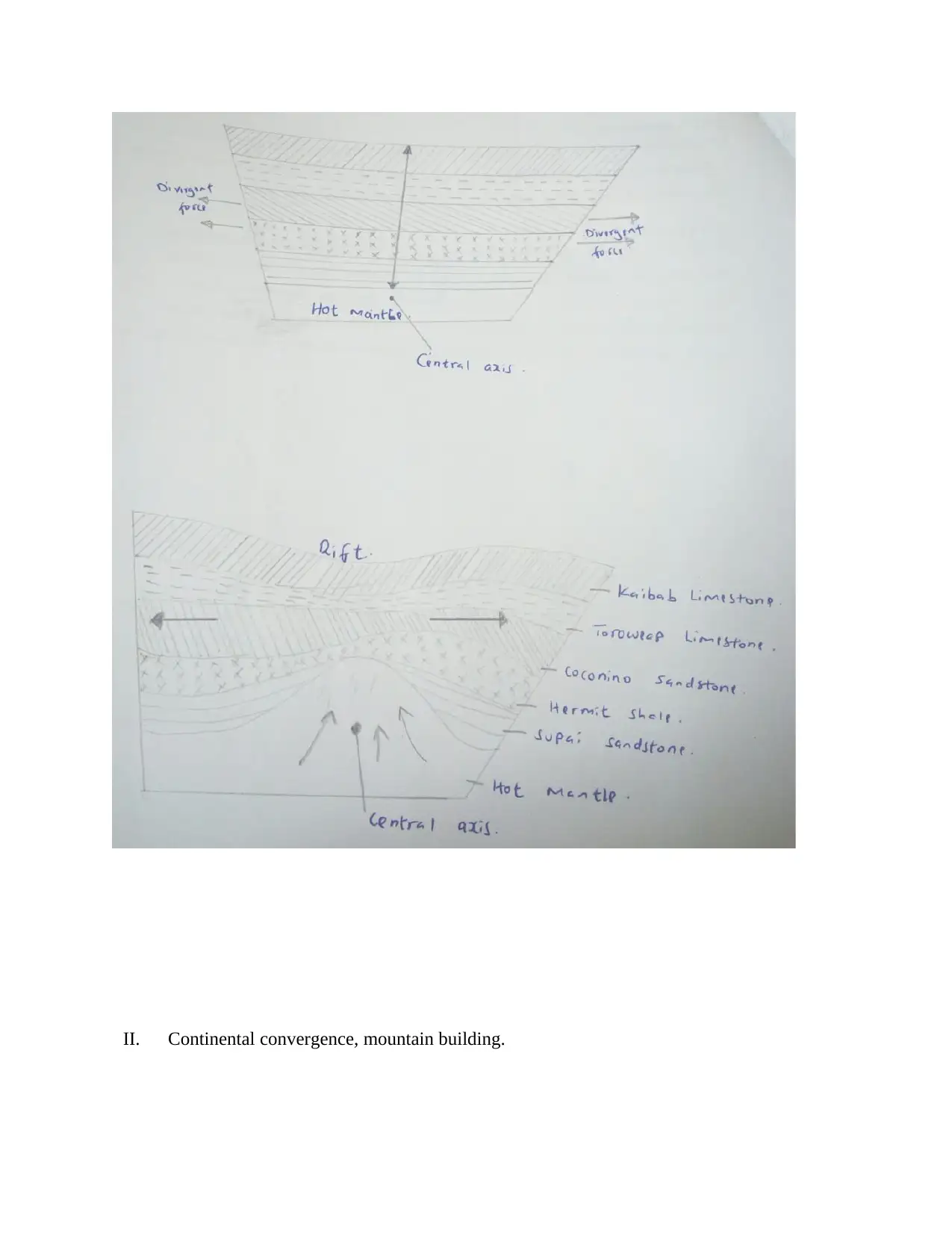
II. Continental convergence, mountain building.
⊘ This is a preview!⊘
Do you want full access?
Subscribe today to unlock all pages.

Trusted by 1+ million students worldwide
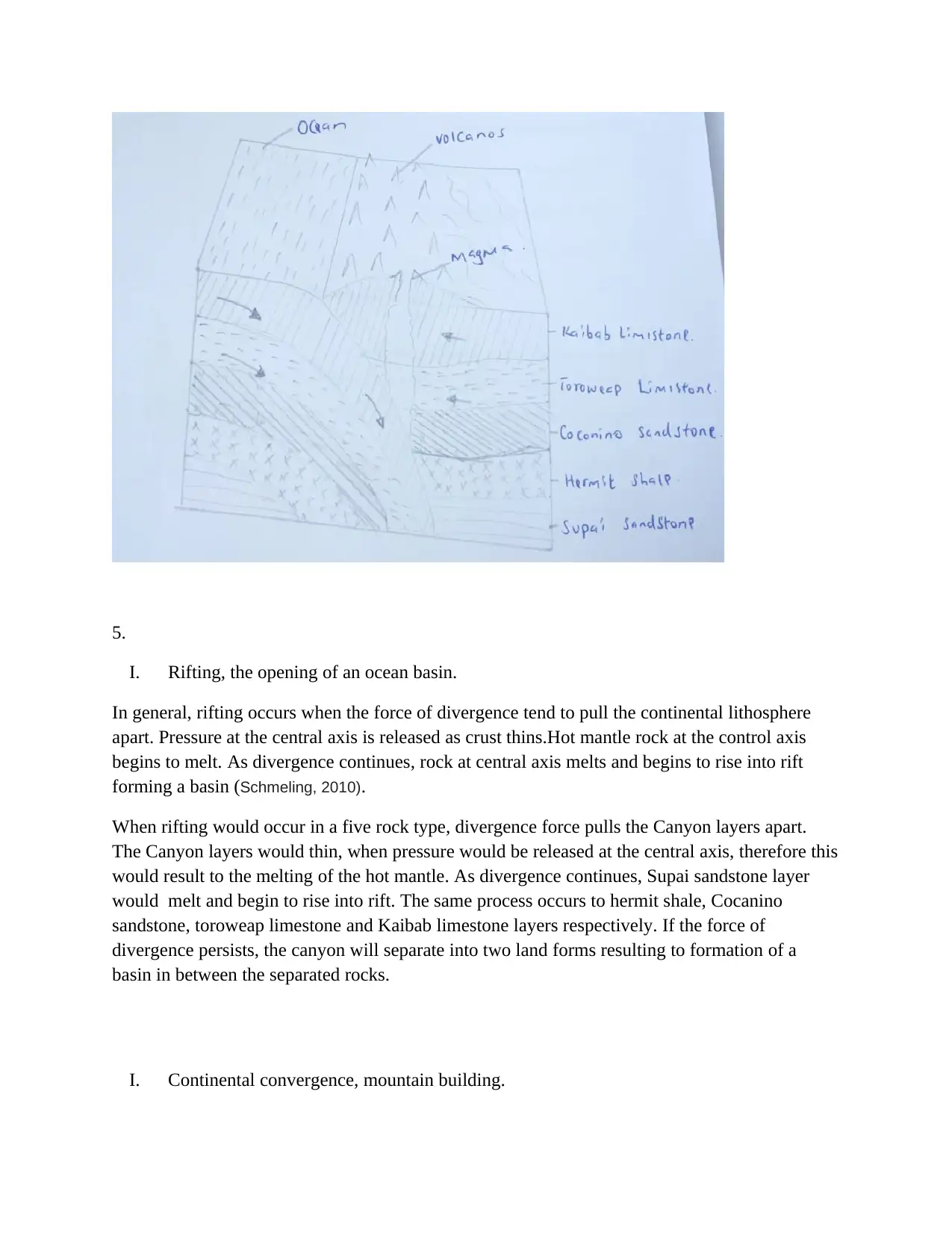
5.
I. Rifting, the opening of an ocean basin.
In general, rifting occurs when the force of divergence tend to pull the continental lithosphere
apart. Pressure at the central axis is released as crust thins.Hot mantle rock at the control axis
begins to melt. As divergence continues, rock at central axis melts and begins to rise into rift
forming a basin (Schmeling, 2010).
When rifting would occur in a five rock type, divergence force pulls the Canyon layers apart.
The Canyon layers would thin, when pressure would be released at the central axis, therefore this
would result to the melting of the hot mantle. As divergence continues, Supai sandstone layer
would melt and begin to rise into rift. The same process occurs to hermit shale, Cocanino
sandstone, toroweap limestone and Kaibab limestone layers respectively. If the force of
divergence persists, the canyon will separate into two land forms resulting to formation of a
basin in between the separated rocks.
I. Continental convergence, mountain building.
I. Rifting, the opening of an ocean basin.
In general, rifting occurs when the force of divergence tend to pull the continental lithosphere
apart. Pressure at the central axis is released as crust thins.Hot mantle rock at the control axis
begins to melt. As divergence continues, rock at central axis melts and begins to rise into rift
forming a basin (Schmeling, 2010).
When rifting would occur in a five rock type, divergence force pulls the Canyon layers apart.
The Canyon layers would thin, when pressure would be released at the central axis, therefore this
would result to the melting of the hot mantle. As divergence continues, Supai sandstone layer
would melt and begin to rise into rift. The same process occurs to hermit shale, Cocanino
sandstone, toroweap limestone and Kaibab limestone layers respectively. If the force of
divergence persists, the canyon will separate into two land forms resulting to formation of a
basin in between the separated rocks.
I. Continental convergence, mountain building.
Paraphrase This Document
Need a fresh take? Get an instant paraphrase of this document with our AI Paraphraser
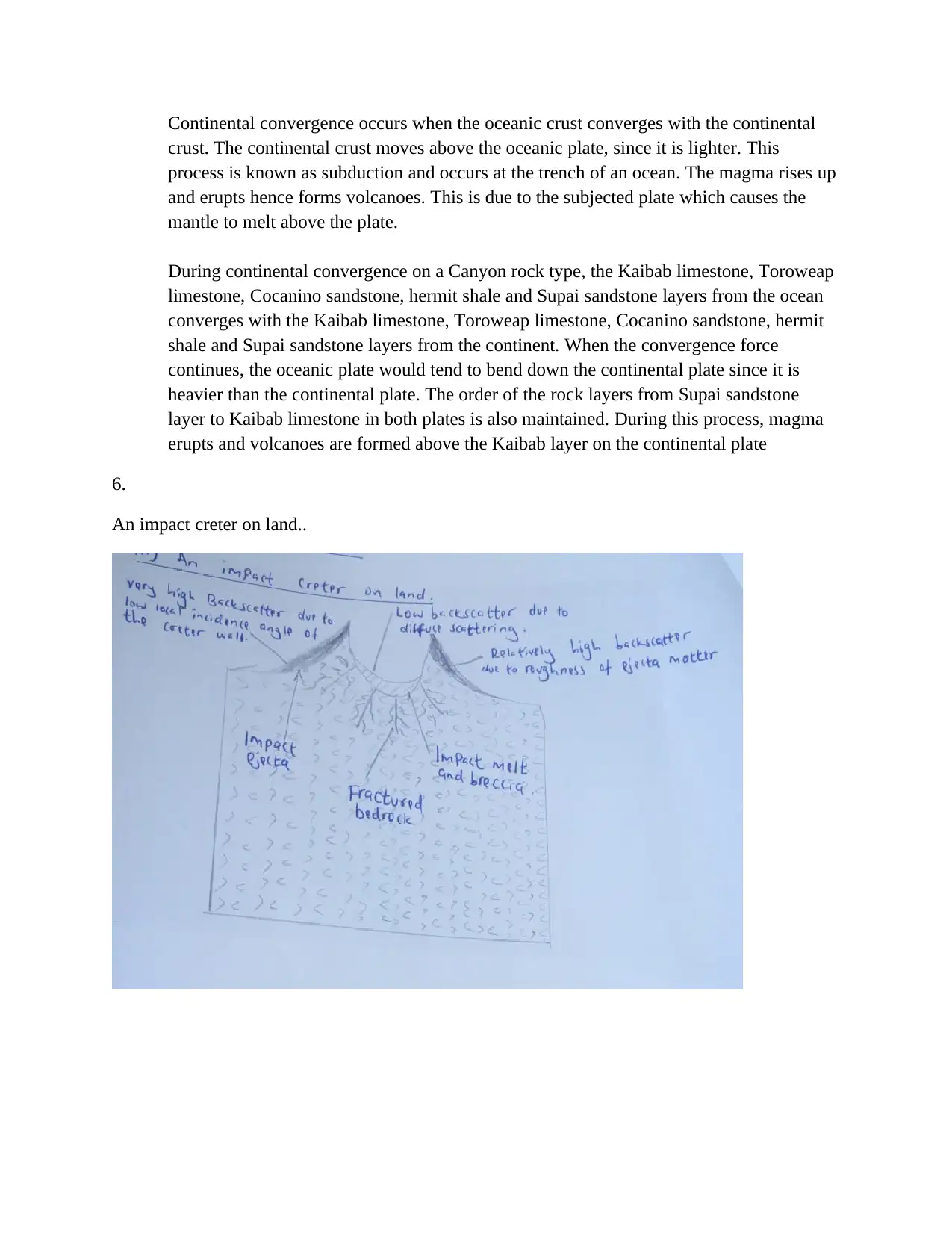
Continental convergence occurs when the oceanic crust converges with the continental
crust. The continental crust moves above the oceanic plate, since it is lighter. This
process is known as subduction and occurs at the trench of an ocean. The magma rises up
and erupts hence forms volcanoes. This is due to the subjected plate which causes the
mantle to melt above the plate.
During continental convergence on a Canyon rock type, the Kaibab limestone, Toroweap
limestone, Cocanino sandstone, hermit shale and Supai sandstone layers from the ocean
converges with the Kaibab limestone, Toroweap limestone, Cocanino sandstone, hermit
shale and Supai sandstone layers from the continent. When the convergence force
continues, the oceanic plate would tend to bend down the continental plate since it is
heavier than the continental plate. The order of the rock layers from Supai sandstone
layer to Kaibab limestone in both plates is also maintained. During this process, magma
erupts and volcanoes are formed above the Kaibab layer on the continental plate
6.
An impact creter on land..
crust. The continental crust moves above the oceanic plate, since it is lighter. This
process is known as subduction and occurs at the trench of an ocean. The magma rises up
and erupts hence forms volcanoes. This is due to the subjected plate which causes the
mantle to melt above the plate.
During continental convergence on a Canyon rock type, the Kaibab limestone, Toroweap
limestone, Cocanino sandstone, hermit shale and Supai sandstone layers from the ocean
converges with the Kaibab limestone, Toroweap limestone, Cocanino sandstone, hermit
shale and Supai sandstone layers from the continent. When the convergence force
continues, the oceanic plate would tend to bend down the continental plate since it is
heavier than the continental plate. The order of the rock layers from Supai sandstone
layer to Kaibab limestone in both plates is also maintained. During this process, magma
erupts and volcanoes are formed above the Kaibab layer on the continental plate
6.
An impact creter on land..
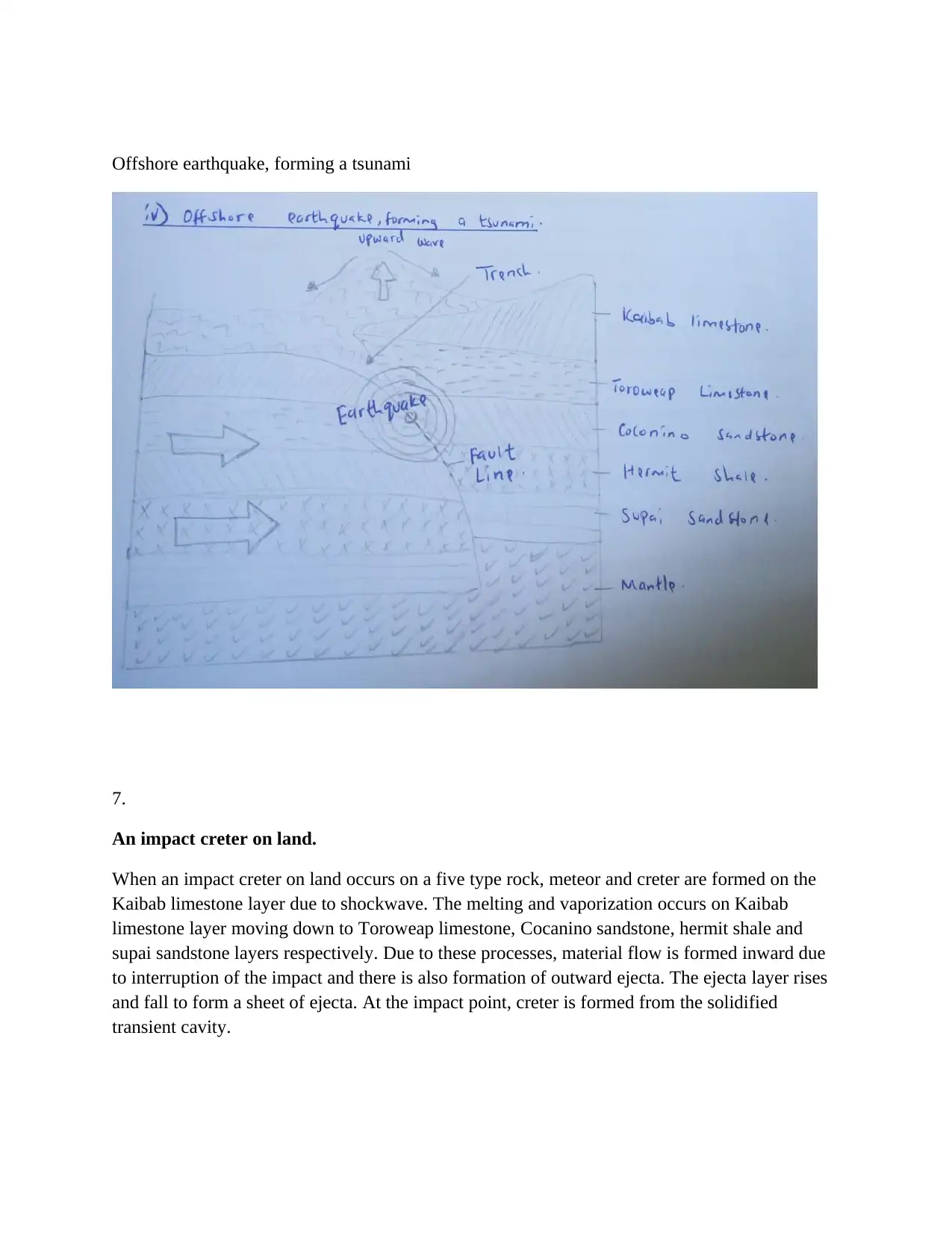
Offshore earthquake, forming a tsunami
7.
An impact creter on land.
When an impact creter on land occurs on a five type rock, meteor and creter are formed on the
Kaibab limestone layer due to shockwave. The melting and vaporization occurs on Kaibab
limestone layer moving down to Toroweap limestone, Cocanino sandstone, hermit shale and
supai sandstone layers respectively. Due to these processes, material flow is formed inward due
to interruption of the impact and there is also formation of outward ejecta. The ejecta layer rises
and fall to form a sheet of ejecta. At the impact point, creter is formed from the solidified
transient cavity.
7.
An impact creter on land.
When an impact creter on land occurs on a five type rock, meteor and creter are formed on the
Kaibab limestone layer due to shockwave. The melting and vaporization occurs on Kaibab
limestone layer moving down to Toroweap limestone, Cocanino sandstone, hermit shale and
supai sandstone layers respectively. Due to these processes, material flow is formed inward due
to interruption of the impact and there is also formation of outward ejecta. The ejecta layer rises
and fall to form a sheet of ejecta. At the impact point, creter is formed from the solidified
transient cavity.
⊘ This is a preview!⊘
Do you want full access?
Subscribe today to unlock all pages.

Trusted by 1+ million students worldwide
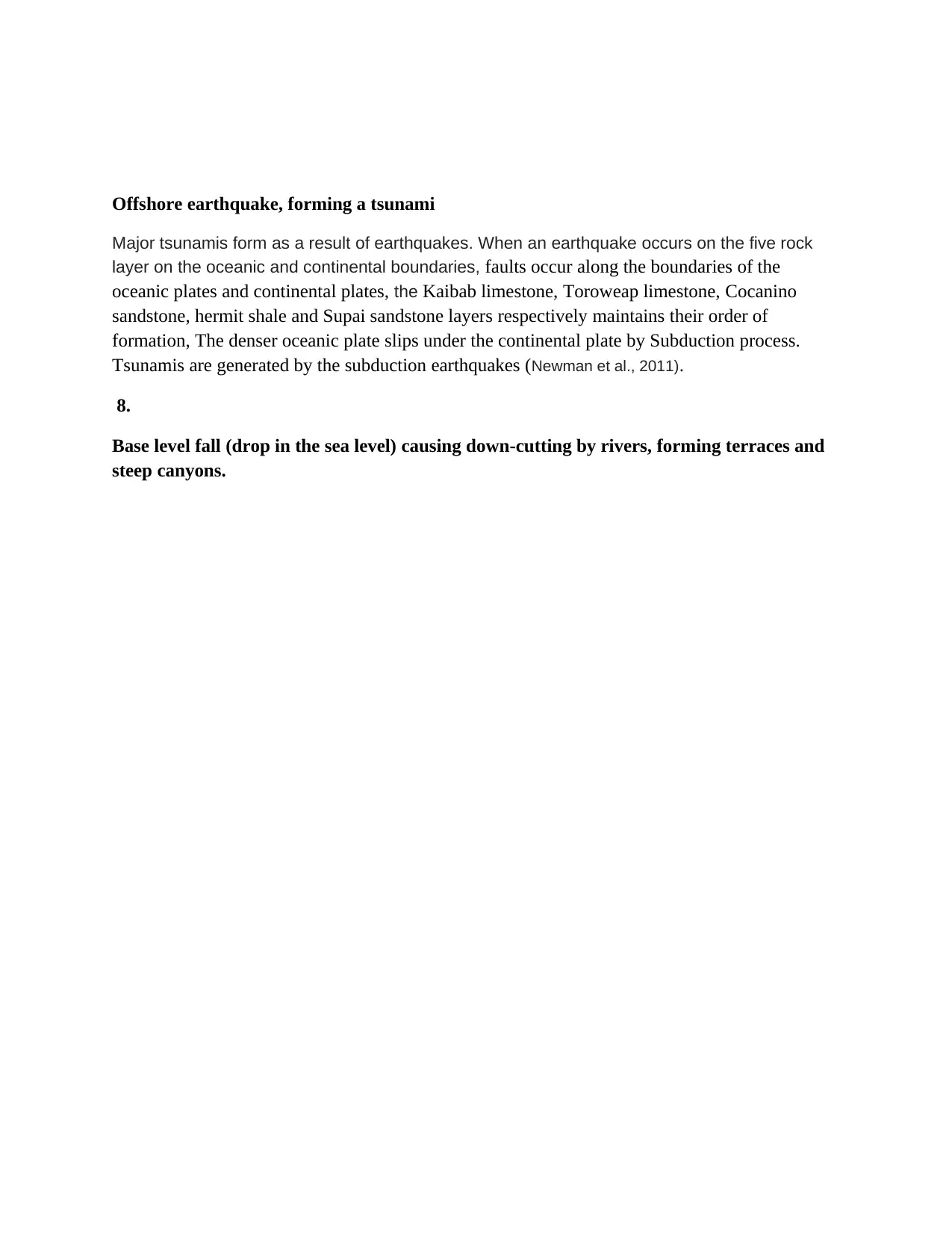
Offshore earthquake, forming a tsunami
Major tsunamis form as a result of earthquakes. When an earthquake occurs on the five rock
layer on the oceanic and continental boundaries, faults occur along the boundaries of the
oceanic plates and continental plates, the Kaibab limestone, Toroweap limestone, Cocanino
sandstone, hermit shale and Supai sandstone layers respectively maintains their order of
formation, The denser oceanic plate slips under the continental plate by Subduction process.
Tsunamis are generated by the subduction earthquakes (Newman et al., 2011).
8.
Base level fall (drop in the sea level) causing down-cutting by rivers, forming terraces and
steep canyons.
Major tsunamis form as a result of earthquakes. When an earthquake occurs on the five rock
layer on the oceanic and continental boundaries, faults occur along the boundaries of the
oceanic plates and continental plates, the Kaibab limestone, Toroweap limestone, Cocanino
sandstone, hermit shale and Supai sandstone layers respectively maintains their order of
formation, The denser oceanic plate slips under the continental plate by Subduction process.
Tsunamis are generated by the subduction earthquakes (Newman et al., 2011).
8.
Base level fall (drop in the sea level) causing down-cutting by rivers, forming terraces and
steep canyons.
Paraphrase This Document
Need a fresh take? Get an instant paraphrase of this document with our AI Paraphraser
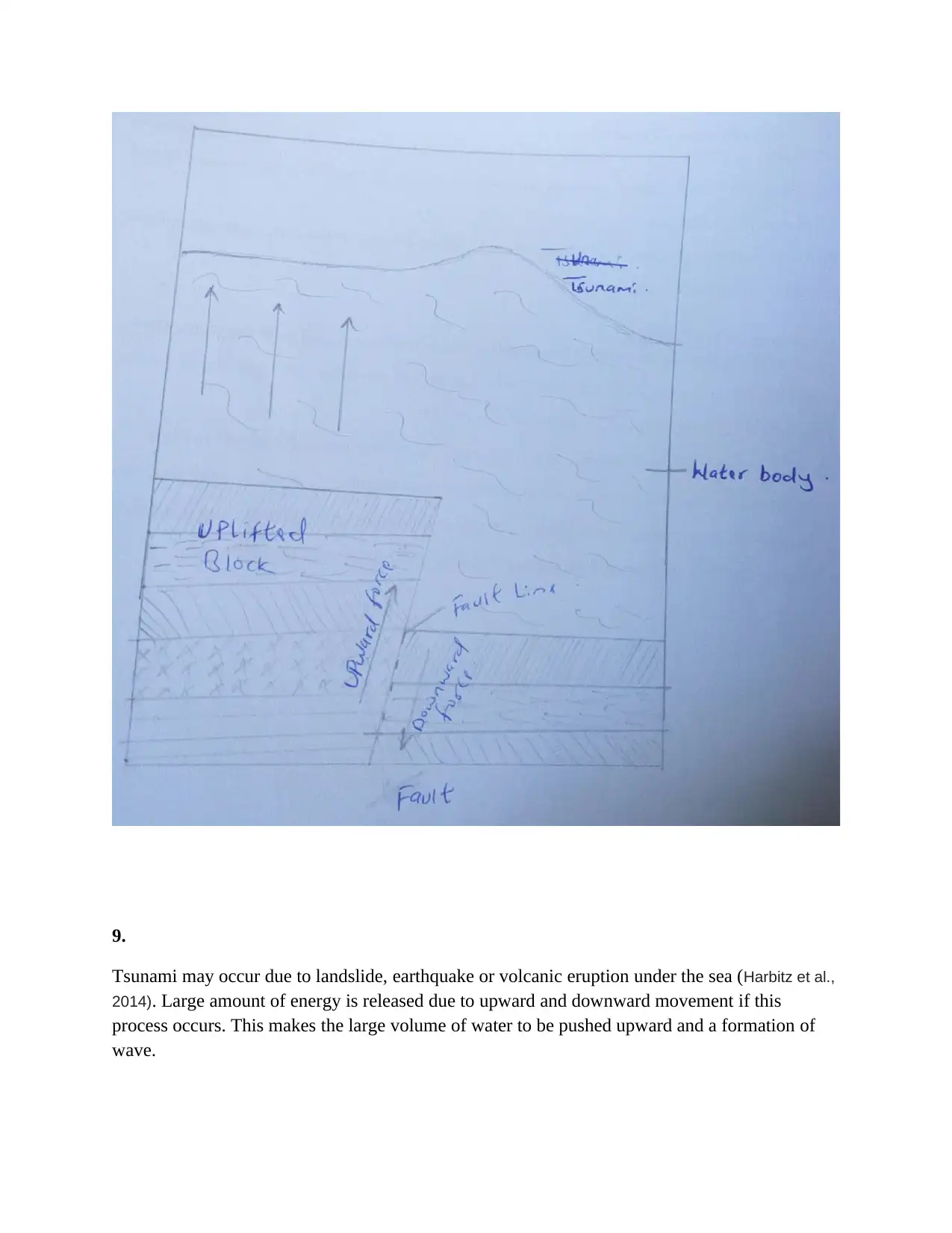
9.
Tsunami may occur due to landslide, earthquake or volcanic eruption under the sea (Harbitz et al.,
2014). Large amount of energy is released due to upward and downward movement if this
process occurs. This makes the large volume of water to be pushed upward and a formation of
wave.
Tsunami may occur due to landslide, earthquake or volcanic eruption under the sea (Harbitz et al.,
2014). Large amount of energy is released due to upward and downward movement if this
process occurs. This makes the large volume of water to be pushed upward and a formation of
wave.
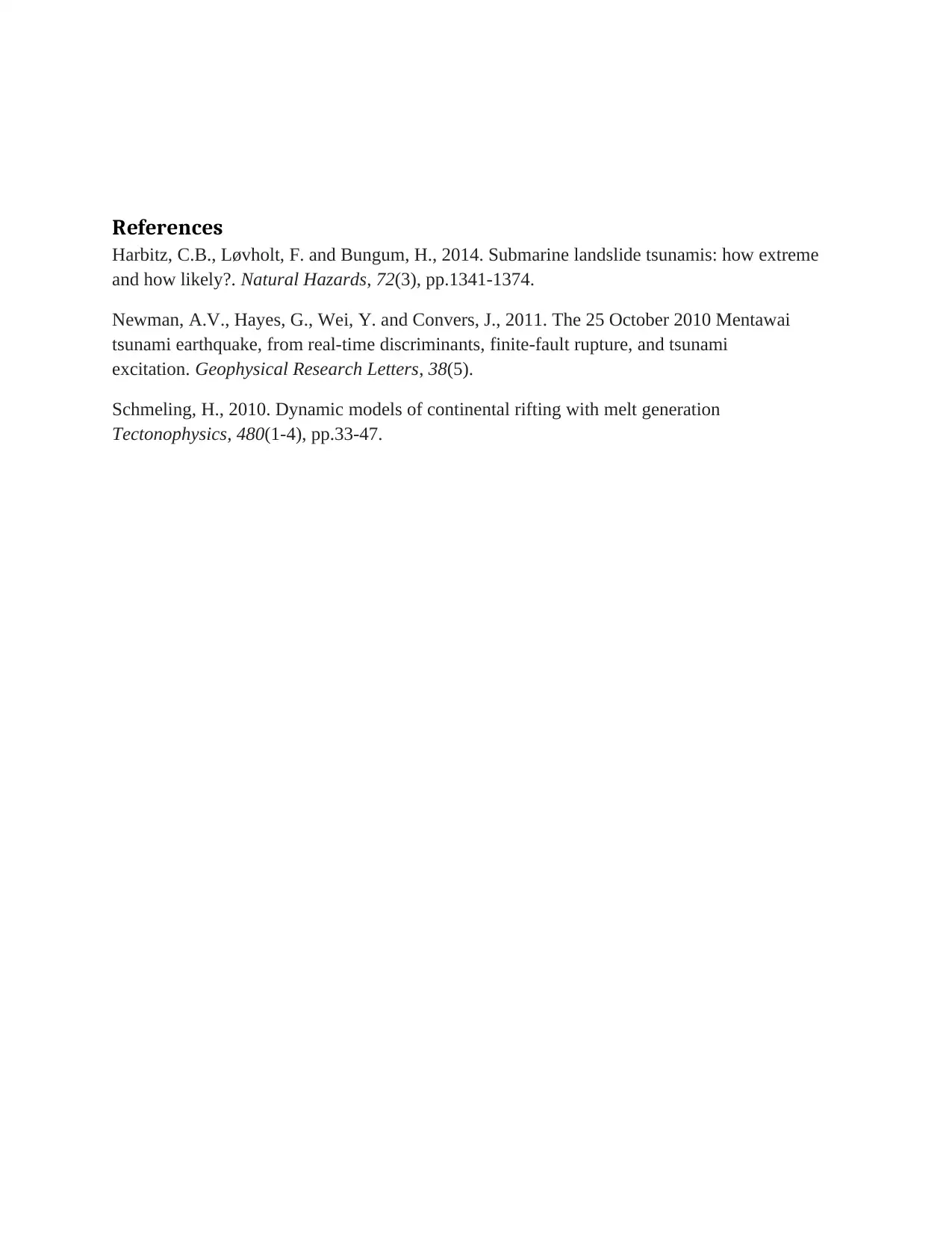
References
Harbitz, C.B., Løvholt, F. and Bungum, H., 2014. Submarine landslide tsunamis: how extreme
and how likely?. Natural Hazards, 72(3), pp.1341-1374.
Newman, A.V., Hayes, G., Wei, Y. and Convers, J., 2011. The 25 October 2010 Mentawai
tsunami earthquake, from real‐time discriminants, finite‐fault rupture, and tsunami
excitation. Geophysical Research Letters, 38(5).
Schmeling, H., 2010. Dynamic models of continental rifting with melt generation
Tectonophysics, 480(1-4), pp.33-47.
Harbitz, C.B., Løvholt, F. and Bungum, H., 2014. Submarine landslide tsunamis: how extreme
and how likely?. Natural Hazards, 72(3), pp.1341-1374.
Newman, A.V., Hayes, G., Wei, Y. and Convers, J., 2011. The 25 October 2010 Mentawai
tsunami earthquake, from real‐time discriminants, finite‐fault rupture, and tsunami
excitation. Geophysical Research Letters, 38(5).
Schmeling, H., 2010. Dynamic models of continental rifting with melt generation
Tectonophysics, 480(1-4), pp.33-47.
⊘ This is a preview!⊘
Do you want full access?
Subscribe today to unlock all pages.

Trusted by 1+ million students worldwide
1 out of 9
Your All-in-One AI-Powered Toolkit for Academic Success.
+13062052269
info@desklib.com
Available 24*7 on WhatsApp / Email
![[object Object]](/_next/static/media/star-bottom.7253800d.svg)
Unlock your academic potential
Copyright © 2020–2025 A2Z Services. All Rights Reserved. Developed and managed by ZUCOL.
